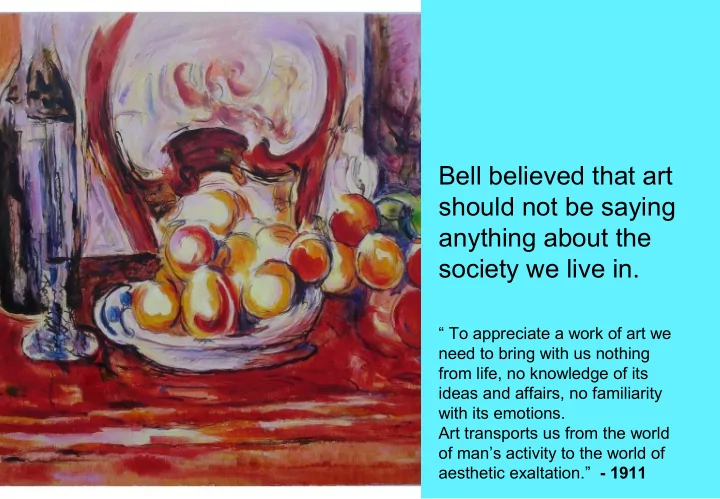

Bell believed that art should not be saying anything about the society we live in. “ To appreciate a work of art we need to bring with us nothing from life, no knowledge of its ideas and affairs, no familiarity with its emotions. Art transports us from the world of man’s activity to the world of aesthetic exaltation.” - 1911
Clive Bell - English art critic and philosopher. Pre World War 1. Defender of the avante garde = modernism = Post Impressionism. Exponent of Formalism. Developer of the aesthetic theory of Significant Form. Van Gogh Starry Night 1889 Seurat The Circus 1890
Clement Greenberg - American art critic. Post World War 1. Defender of the avante garde = Abstract Expressionism, Post-Painterly Abstraction and Colour Field Painting. Exponent of Formalism and the aesthetic theory of Significant Form. Jackson Pollock Autumn Rhythm 1950 Frank Stella Hyena Stomp 1962 Mark Rothko Light Red Over Black 1957
Formalism is all about the Form Bell says “the most important aspect of a work of art is its Form. The way it is made and how it looks. NOT its narrative content NOR its relationship to the visible world.” Greenberg says “Form is the quality Van Gogh Sunflowers 1888 through which a painting or sculpture refers to its medium and to its own conditions of creation. Seeing what is in a work or what it ‘says’ is not the point; the astute viewer (with taste) is meant to see the work’s very flatness or its way of dealing with paint as paint.” Jason Pollock Mural 1943
They said that when we see a good piece of art we experience an ‘aesthetic emotion’. Good art can be a painting or sculpture from any period or country and can trigger completely different aesthetic responses. What do they all have in common? Bell called the one quality they all have in common - Significant Form Poussin, Helios and Phaeton with Saturn Alchemist with his furnace. Fresco, and the Four Seasons c.1635 Padua c. 1380 Blue Virgin Window at Chartres Cathedral c.1150
Bell and Greenberg say that - ‘Significant Form’ is a particular combination of line and colour that stirs our aesthetic emotions Seurat Morris Louis Bathers at Asniéres 1984 'Where’ 1960
Grosz believed that art should be saying everything about the society we live in. “ … the meaning, nature and history of art are directly related to the meaning, history and nature of society. The prerequisite for the perception and evaluation of contemporary art is an intellect directed at the knowledge of facts and of correlations with real life and all its convulsions and tensions.” - 1925 George Grosz. Pillars of society 1926
George Grosz - German Modern Realist artist in 1920s Member of New Objectivity Art movement that vividly depicted and satirized the corruption, frantic pleasure seeking and demoralization of Germany after the Great War Otto Dix George Grosz Christian Schad Sylvi the Journalist 1926 Pillars of Society 1927 Self portrait 1927
Grosz hated the war, the military and the war profiteers. His experiences in the army deepened his intense loathing for German society. In this 1916 modern Dance of Death Grosz explained - “a strange street by night, a hellish procession of dehumanized figures mills, their faces reflecting alcohol, syphilis, plague…I painted this protest against a humanity that had gone insane” George Grosz Dedicated to Oskar Panizza 1916
In Germany, Hitler labeled modern art as ‘degenerate’ and banned on the grounds of being un-German or Jewish Bolshevist. Exhibitions were organized and the pictures ridiculed and burnt. Artists were forbidden to exhibit, sell or even paint. Adolf Hitler and Adolf Ziegler inspect the installation by Willrich and Hansen of the Degenerate Art Show, 1937
Fine arts were used to further the fascist ideology. Art returned to classical realism and propaganda. Under Hitler there was no free expression. Ernst Lieberman By the water 1930s “Give me four years’ time” NAZI propaganda poster, photomontage, 1937
Clive Bell and Clement Greenberg - little experience of war 1. Art should not be saying anything about the society we live in 2. Art must make us forget 3. Descriptive art is weak. Realism is a sign of weakness in the artist 4. Art is not about content – its about form, colour, line and the medium 5. Good art has significant form and triggers an aesthetic response in you 6. Art is about the beauty of the art itself – the sublime George Grosz - first hand experience of war 1. Art should be saying everything about the society we live in 2. Art must make you remember 3. Art that does not tell a story and is inane and useless 4. Art is all about the content 5. Art must make you feel the emotion the artist wants you to feel 6. Art is a savage satirical attack on the human condition Top: Paul Cezanne The Gardener Vallier 1906 Left: George Grosz Beauty I wish to Praise Thee 1919
Recommend
More recommend